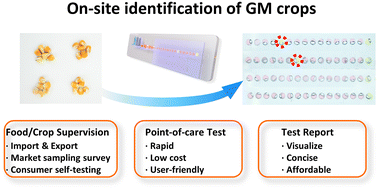A point-of-care testing platform for on-site identification of genetically modified crops†
Abstract
Genetically modified (GM) food is still highly controversial nowadays. Due to the disparate policies and attitudes worldwide, demands for a rapid, cost-effective and user-friendly GM crop identification method are increasingly significant for import administration, market supervision, etc. However, as the most-recognized methods, nucleic acid-based identification approaches require bulky instruments, long turn-around times and trained personnel, which are only suitable in laboratories. To fulfil the urgent needs of on-site testing, we develop a point-of-care testing platform that is able to identify 12 types of GM crops in less than 40 minutes without using laboratory settings. Our system integrates sample pre-treatment modules in a microfluidic chip, performs DNA amplification via a battery-powered portable kit, and presents results via eye-recognized colorimetric change. A paraffin-based reflow method and a slip plate-based fluid switch are developed to encapsulate and release amplification primers in individual microwells on demand, thus enabling identification of varied targets simultaneously. Our system offers an efficient, affordable and convenient tool for GM crop identification, thus it will not only benefit customs and market administration bureaus, but also satisfy demands of numerous consumers.



 Please wait while we load your content...
Please wait while we load your content...